
 |
800.514.3066customer service |
||
|
|
Kaydon white papers4-point bearings do triple duty while saving spaceA four-point contact ball bearing makes it easy to simplify machine designs that have a combination of radial, thrust and moment loads because it can handle all three simultaneously. They are primarily used for slow to moderate-speed applications, or where oscillatory movement is predominant. 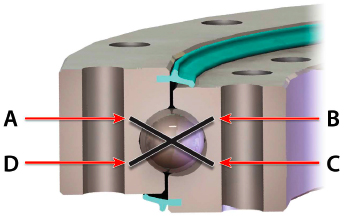
A single four-point contact bearing usually makes a second bearing unnecessary,
which provides some very important benefits:
Thanks to a unique ball path geometry that produces twice as many contact points, a four-point contact bearing can resist radial, thrust and moment loads individually or in any combination. It has one row of balls with an inner race and an outer race. The ball grooves are generated from two centers, with each radius slightly larger than the ball radius. Contact angles are typically 35° off the radial centerline, but can be varied to suit the application. 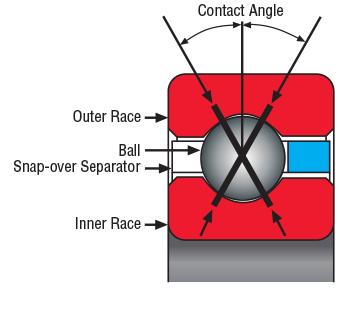
Important advantagesFour-point contact bearings are especially effective in applications in which the rotating element has a high ratio of diameter to axial length. Most have a large ratio of bore to section size: the larger this ratio, the thinner and more flexible are the individual races. Thin section bearing sizes range from 1" to 40" and slewing ring bearings range from 4" to 178" O.D. Figures 1 and 2 show how much space can be saved by replacing two bearings with one four-point contact bearing. The rotary table design in Figure 1 has a conventional center post supported by two bearings. Eliminating that center post (Figure 2) reduces the height and weight of the table and frees space to be used by other components. And without a post, there is no chance of post deflection. 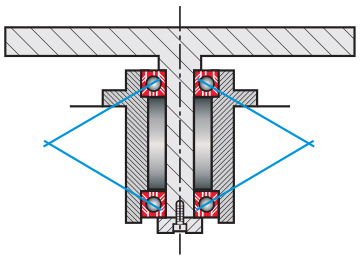
Figure 1 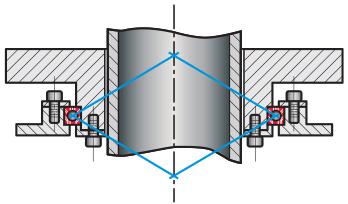
Figure 2 Similarly, having a single bearing means no runout matching, no diameter matching, and no chance of wobble from two bearings with unequal runout. All of this enhances the accuracy of the assembly. Eliminating a second bearing also eliminates adjustments to optimize its fit, and thus the expense of spacers or clamping rings (and perhaps technicians skilled in making these adjustments). In contrast, a four-point contact ball bearing is manufactured with the proper internal fit and is simply fastened to its mating parts. Finally, eliminating a second bearing saves money that can be used to integrate features (gears, mounting holes, lubrication fittings) into the four-point contact bearing to further optimize performance. Twice as accurateFour-point contact bearings can be manufactured in accordance with ABEC precision grades and in larger sizes. In applications involving oscillatory motion with limited angles of rotation, when the runout is zero for much of the rotation, an ABEC 1 bearing can sometimes be used instead of an ABEC 3 or 5. In such cases, the critical requirement (axial runout or radial runout) should be specified to meet ABEC standards. Noncritical areas can be left up to the bearing manufacturer. With one row of balls instead of two, accuracy is enhanced in several ways. For example, when radial runouts in a two-row system are out of phase, the rotation will produce a wobble. Wobble can also result from structure deflection when applications require a lot of space between two rows of balls (e.g., when high moment load must be resisted). And if there is a preload difference in axial runout between the two rows, bearing friction can vary. None of these problems will occur in a bearing with a single row of balls. Likewise, there is no matching of housing bores and shoulders, or of shaft diameters and shoulders. All other factors being equal, the accuracy of a four-point contact bearing may be twice that of a bearing with two rows of balls. Choice of materialsFour-point contact ball bearings are typically manufactured of conventional antifriction bearing materials but, like other bearings, materials decisions are ultimately dictated by the application. High-carbon 52100 alloy and 440C stainless steel are common choices for through hardening. When selective hardening is needed—such as when a bearing has integral features, like flanges and gears—options include carburizing or induction hardening. Alloys such as 8620, 4340, 4150, and 1552 are utilized for this purpose. All can be hardened to Rc 58 for 100% bearing capacity and maximum service life. (At Rc 50 capacity drops to about 50% and at Rc 45, to less than 30%.) When corrosion resistance is important, races and balls can be made of precipitation-hardened stainless steels or coated with a thin dense chrome, such as Endurakote® plating. Limiting speedsFour-point contact bearings are primarily used for slow to moderate-speed applications. Under combined loads, some of the balls are loaded across both sets of contacts. Since they cannot roll about two axes simultaneously, they tend to rotate about one axis. This leads to more skidding or slippage on the other set of contacts, increasing friction and wear...especially at high speeds. Maximum allowable speeds vary with bore size, section size, ball size, retainer type, type of lubrication, and type of loading. As a rule of thumb, this type of bearing performs best at pitch line velocities under 1,100 feet per minute. However, the variable effects of preloading, lubrication and simultaneous individual loads can overcome this limitation. For applications requiring higher speeds the bearing manufacturer should be consulted. Under a single loading (radial or thrust), speed is no more a factor for a four-point contact ball bearing than that it would be for a conventional radial bearing or an angular contact thrust bearing. Lubrication and maintenanceIn most applications, four-point contact ball bearings need no more maintenance than any other antifriction bearing. Often they need even less. Grease lubrication is typical, since so many applications involve low speeds or oscillating motion. If the application involves full rotation, two grease fittings mounted 180 degrees apart should allow sufficient access. But if a design calls for heavy loads as well as full rotation—or if the bearing is located near other moving parts that must be lubricated with oil—oil lubrication is used instead. Many bearings are pre-lubricated at the factory, but even so lubricant must be replenished and replaced every so often. The incorporation of holes or fittings into the bearing races makes this easier. This is especially true when the bearings have integral seals, which is possible even in large-diameter bearings (e.g., 100 inches). 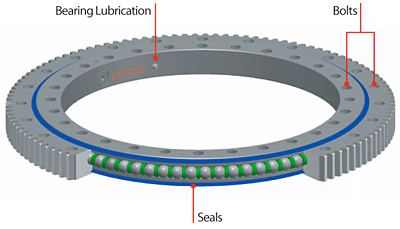
SeparatorsSeparators should always be used in four-point contact bearings, and the style varies with the application. Material options include steel, stainless steel, bronze, phenolic, nylon, Teflon, and stainless steel wire (spring-type). The most common style is the retainer found in a Conrad deep-groove bearing, which can be inserted into the bearing from the side through the gap between the race lands. A full one-piece retainer is usually the strongest option, but inserting it into a fourpoint contact bearing requires splitting one of the races or providing a loading plug. This is not practical in light-section bearings because the race is too thin to split and cannot be reassembled with rivets or screws. When a thin section bearing application demands maximum capacity in a slow-speed bearing and separation of the balls, a wire separator is a good choice. Spring-type separators are used in low-frequency, oscillating, or slow full-rotational applications, where low, uniform bearing torque is important. The springs act as free-floating bodies to keep sliding friction very low. ConclusionToday, more than ever, design engineers are challenged to simplify designs in order to reduce cost and weight. In many applications, four-point contact ball bearings—which do the job of multiple bearings by handling radial, thrust and moment loads simultaneously—are an ideal solution. Kaydon Bearings has manufactured thin section and slewing ring bearings in four-point contact configurations for many years, and specializes in helping designers turn ideas into engineered solutions. For more information, or to discuss a potential application with one of our experienced application engineers, please contact us. Download this article
4-point bearings do triple duty while saving space |
Moment load is much the same, passing a thrust load from the inner race at point B, and to the outer race at point D. At the same time, a thrust load 180° opposite is passed from the inner race at point C to the outer race at point A. Radial resistance occurs 180° from the point of application (assuming much larger thrust load than radial load) and the radial load is resisted equally across the lines of contact CA and BD. The relationship of the individual loads determines whether the reactions are large or small.
|
|